Urban defences proper were not the only fortifications in medieval towns. In many the king or other lord of the town had a castle; and/or the precincts of cathedrals, abbeys, or priories might be walled and have sturdy-looking gateways. Defence may have been one purpose, since large churches, known repositories of precious objects, had been targets for raiders in the Early Middle Ages, and in some cases (on the borders) in later centuries. But a more prominent concern may have been to define the boundaries of the precincts and make a visual statement about the importance, sacrosanctity, and jurisdictional independence of the religious house. In terms of protection, the most common risk was mob violence from the people of the town in which the religious house was located, for jurisdictional rivalries had a tendency to boil over occasionally.
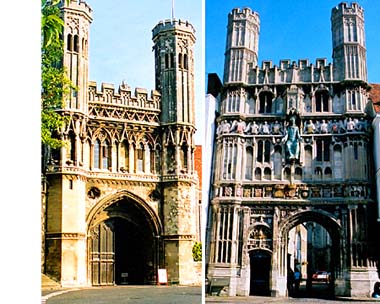
The gateways to two religious precincts
at Canterbury show more interest in conspicuous display of wealth
and prestige than in defensibility. (left) Fyndon's Gate, built
1309 (to replace an earlier gateway), was the main entrance into
the grounds of St. Augustine's Abbey.
(right) The lavishly decorated Christchurch Gate is the main entrance
into the cathedral precinct. It was built in 1517 to commemorate
the marriage of Henry VII's heir and the decorations include
several Tudor symbols.
Photos © S. Alsford
Canterbury's fortifications give a hint of rivalry between municipal and ecclesiastical authorities. The great gateway into the abbey (whose precinct lay immediately south-east of the city) faced towards the wall around the city. In 1425, the closest town gate (Burgate) was rebuilt in a style that seems to mirror the abbey gate features. After the Dissolution, the city was able to have the abbey walls demolished, and scavenge the stone for repairs to Burgate.
Norwich provides a notorious case of town and cowl conflict: in 1272 escalating violence culminated in a siege by townsmen of the cathedral-priory precinct; despite the Prior of Norwich bringing in mercenaries from Yarmouth and equipping them with anti-personnel artillery, the precinct defences were breached and its buildings severely damaged and looted. As part of their punishment, the citizens paid for the building of a new precinct gateway to replace one they had destroyed.
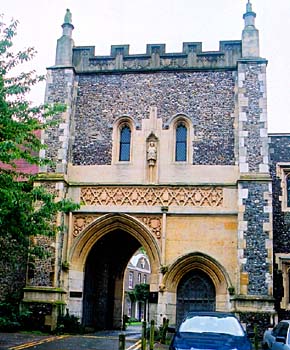
Bishop Alnwick's Gate, part of the
Norwich cathedral precinct enclosure. Although it receives less
attention than the visually more interesting
Ethelbert Gate
and Erpingham Gate,
the Alnwick Gate is a good example of a Perpendicular gateway into an
ecclesiastical liberty. Bishop Alnwick had it built in the 1430s
as the principal entrance to the palace section of the cathedral close.
Photo © S. Alsford
Another fortification associated with Norwich's cathedral-priory is the free-standing structure now known as the Cow Tower. A point defence, not connected to the city wall, but serving to protect a bend in the Wensum just before the river approaches the city quayside, it stands on the site of an older tower (erected ca.1278) in a meadow, known as Cowholme, with which the Hospital of St. Giles, an episcopal foundation, was endowed. This earlier tower was used by the cathedral-priory as a prison and watch tower and perhaps for toll collection. It was referred to as the donjon when, in a state of deterioration, it was acquired by the city from the Hospital in 1378, in conjunction with royal orders to restore neglected city defences to a fit state. The city authorities approved structural improvements over the next two decades, culminating in a more thorough rebuild in 1398/99. Its design would have allowed defenders to fire on enemies on the far side of the river, but it is doubtful the tower could have withstood a direct assault by any properly equipped force that crossed the river.
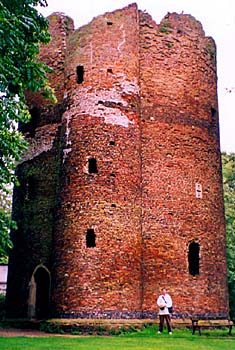
The Cow Tower at Norwich is a three-storey
structure, standing almost 50 feet high, built of flint and encased
in brick. Seemingly designed as a stand-alone artillery fort, it would
have been unique at that period, although the
Bishop's bretask
at Lynn provides an earlier example of a tower not tied in to a built defensive
circuit. The building accounts of 1398/99 included payment to a mason for making
12 "shotholes" to accommodate hand-guns. these were distributed in two tiers
around the tower. Embrasures around the parapet were probably intended to
accommodate cannon. The tower had facilities to house a small garrison
(presumably the gunners) when necessary. Part of it continued to be
described as a dungeon into the late fifteenth century.
Photo © J. Patterson
At York St. Mary's Abbey also experienced conflict with the citizenry. Its precinct lay on the west side of the city, just outside the line of urban defences. One of the wealthiest monasteries in the north, it was endowed by the king with extensive privileges and powers and control over the suburban area of Bootham which, with its own fair and market, posed a competitive threat to the city. Jurisdictional rivalry erupted into violence in the 1260s, with houses in Bootham destroyed, some of the abbot's tenants there killed, and the abbot forced to flee the city.
In the following decades, a wall was built around three sides of the abbey precinct; it incorporated interval towers, a large tower at the northwest corner, a main gateway on the side furthest from the city, and a smaller gate on the opposite side. In its southeast corner it seems to have relied on the city walls and moat for protection. The River Ouse (together with a tower at that end of the wall) protected its fourth side. Royal licence to crenellate was given in 1318, on condition that this final touch not enable the city to be assaulted from the abbey walls.
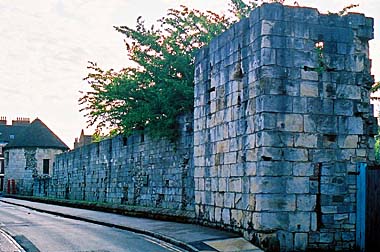
(above) A stretch of St. Mary's Abbey
precinct wall, along Marygate, with a corner tower (St. Mary's Tower)
at the left-hand end, and an interval tower on the right.
(below) In the crenellations along that part of the wall have
been installed louvers, which could be swung open for defending
crossbowmen to fire, and closed to give them protection.
Photos © S. Alsford
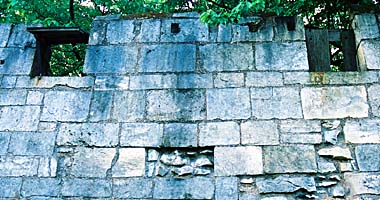
Salisbury provides another example of a walled cathedral close of which remnants survive. After the transfer from Old Sarum of the cathedral community and development of New Salisbury at the new location, the bishop obtained permission from the king to enclose the town with a ditch and later (1367) permission to construct a stone wall; but such a project was apparently beyond local means or will, for in 1378 the citizens were still seeking, and obtaining,from the king resourcing for efforts to complete just a ditch-rampart and wooden palisade; money was still being raised locally for this project in 1440. Later in the century we hear of several town gates. Nothing substantial of the city's defences now survives.
Meanwhile, however, the cathedral close had been walled. Royal licence for this was granted in 1327, trouble between the clerical community and the citizens and the vulnerability of the close to thieves coming from the city being part of the justification; however, the work does not seem to have begun before 1331, when the king authorized scavenging stone from the abandoned cathedral at Old Sarum. The crenellated wall did not enclose the entire cathedral precinct, some of its buildings, such as St. Nicholas' Hospital being left outside.
Three gateways provided access into the close; it is assumed they were built at the same time as the wall. Two of these – the North Gate, which gave onto the city's high street, and St. Ann's Gate – were basic archways with a room built above – that of North Gate being a fifteenth century addition and allowed for installation of a portcullis; the third (South Gate) was plainer, without an upper storey. A fourth gate was added in 1377. Even now the gates continue to be secured each night.
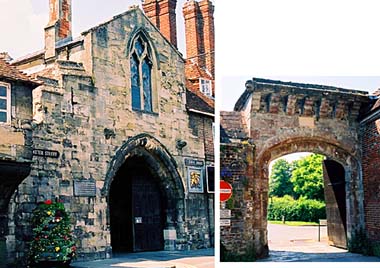
Two of the gateways into the cathedral close at
Salisbury: (left) St. Ann's Gate, topped by a one-room chapel serving a gild of
Vicars Choral. (right)South Gate, a simple archway (topped by a string course
set on moulded brackets) with adjacent gatehouse ;
it gave access towards the hospital and Harnham Bridge.
Photos © S. Alsford